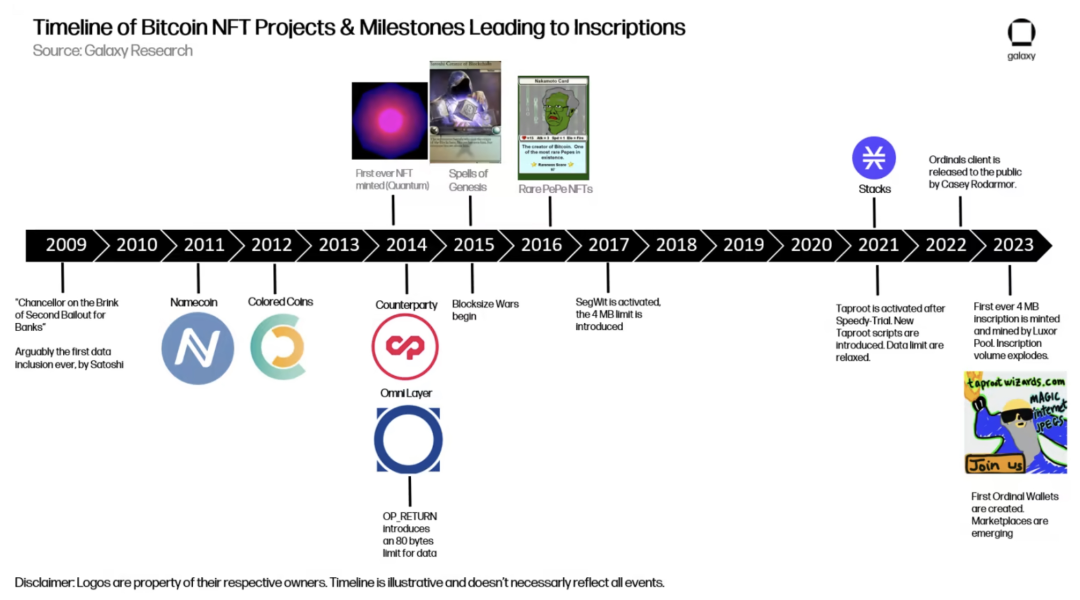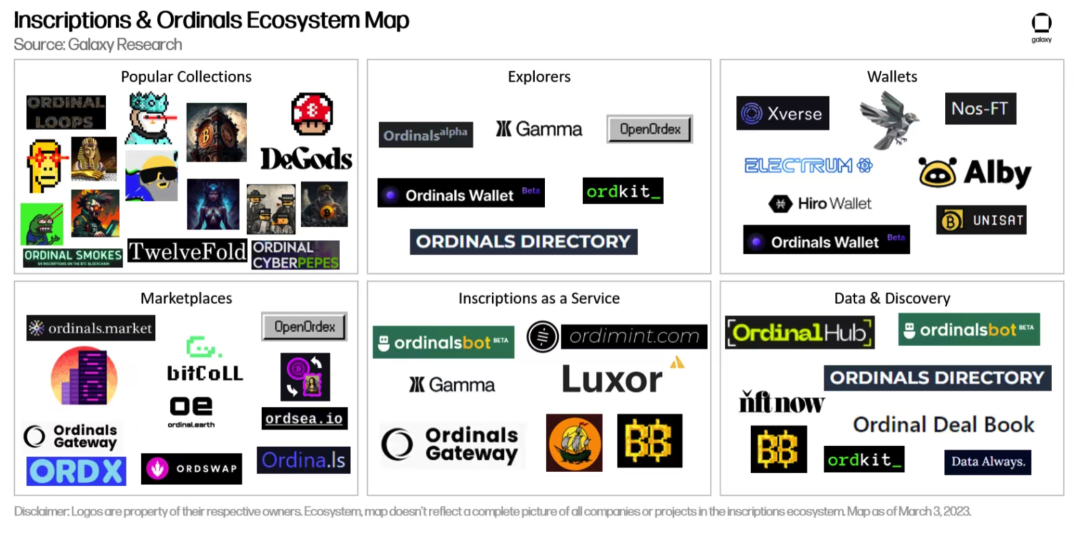The popularity of Bitcoin NFT has continued to rise recently . At present, the total number of inscriptions (that is, Bitcoin NFT) minted on Bitcoin has exceeded 520,000 (according to data from Dune on March 19), while the previous Bitcoin launched by Yugalabs on March 6 The auction of the coin NFT series TwelveFold has pushed Bitcoin NFT to a new climax : there are a total of 300 NFTs in this series, the lowest winning bid price is 2.25 BTC, and the highest winning bid price is 7.11 BTC. The price is 61.59 ETH, worth 3.95 BTC, which shows the popularity of Bitcoin NFT.

Bitcoin's NFT series launched by Yuga Labs -- TwelveFold
So, what exactly are Bitcoin NFTs? Why is it only now? What is the current ecology surrounding Bitcoin NFT? Let's find out.
01
What are Bitcoin NFTs?
We are very familiar with Ethereum NFT. From the early sensational CryptoKitties to the current blue-chip projects Boring Ape, CryptoPunks, Azuki, etc., they are all NFT projects that continue to be popular on Ethereum. It can be said that NFT has entered the public eye with the genes of Ethereum. After the detonation of the Ethereum public chain, it has gradually become an indispensable part of other public chain ecology.
When it comes to Bitcoin NFT, most people may not have much impression. However, in the more than ten years since the birth of Bitcoin, there have been various attempts on NFT, but there has been little movement. Until the emergence of the Ordinals protocol this time, Bitcoin NFT has entered the public eye with a shining attitude.

From 2009 to 2023, the history of NFT exploration on Bitcoin (Galaxy)
So, what is the Ordinals protocol? How to realize the minting of NFT on Bitcoin
We know that NFT is non-fungible tokens, non-homogeneous tokens, that is, each NFT is different and indivisible , and it is realized through token standards such as Erc721 and Erc1155 on Ethereum. However, there is no Turing-complete smart contract on Bitcoin, and these token standards cannot be directly adopted. How can it be realized in Bitcoin?
Casey Rodarmor, the founder of Ordinals, thought of satoshi , the smallest unit of bitcoin . One satoshi is equal to one hundred millionth of a bitcoin, which is indivisible.
The first condition is met, but how to make each Satoshi different? Casey numbered each satoshi, starting with the time they were mined.
For example, when Satoshi Nakamoto dug out the genesis block, he dug out 50 bitcoins at the same time. According to the sequence, the first Satoshi number of the first bitcoin is 0, and the last Satoshi number of the 50th bitcoin is 0. The serial number is 4999999999. In this way, each satoshi has its own unique number and becomes an indivisible and irreplaceable token.
Write pictures, text, audio and even video into the numbered satoshi, and you will cast an irreplaceable and indivisible NFT , that is, Bitcoin NFT. The Ordinals protocol makes the casting of Bitcoin NFT possible.
However, there is a prerequisite for writing pictures and other information into Satoshi: the Bitcoin network allows these contents to be written, and there is enough capacity to store such information.
After all, in the bull market in 2017, for the vigorously hyped Bitcoin expansion event, I must have experienced it vividly: the result of that expansion event was that Bitcoin forked out of BCH, BCH forked out of BSV, and then What followed was a large pile of forked coins that are now almost at zero.
For Bitcoin at that time, the upper limit of the block size was 1MB, and it was not allowed to write large-capacity data (limited to 80kb) into the Bitcoin block. The 1MB capacity to store Bitcoin transaction data was already somewhat stretched, let alone Talk about minting a lot of NFTs.
However, in the Bitcoin expansion discussion in 2017, the Bitcoin community carried out a Segwit upgrade, which upgraded the effective block size of Bitcoin from 1MB to 4MB. In addition, the Taproot upgrade in 2021 released data restrictions, allowing Bitcoin Arbitrary data storage (less than 4MB) is possible in , which laid the foundation for today's Bitcoin NFT.
Since the first NFT was minted at block height 767430 on December 14, 2022, 502,000 Bitcoin NFTs have been minted in the past three months . The minted NFT content includes pictures, text, audio, and video And applications, etc., the most exaggerated is an NFT minted on February 2, 2023, which occupies a capacity of 3.9MB, while the maximum capacity of Bitcoin is only 4MB.

The number of Bitcoin NFT minted on Ordinals on March 16, data source: Dune

Bitcoin block 774628, the block capacity is 3.96MB, data source: mempool
02
What are the characteristics of Bitcoin NFT
1) Data is stored on the Bitcoin chain with high security
The biggest feature of Bitcoin NFT is that the data is completely stored on the Bitcoin blockchain.
As we mentioned above, after Bitcoin has undergone Segwit expansion + taproot upgrade, it allows larger-sized data to be stored on the chain. Therefore, the Ordinals protocol uses this to store all minted NFT original data on the Bitcoin chain.
As a leading project in the encryption industry, Bitcoin has been established for more than ten years. Its security is obvious to all. It is the public chain with the highest degree of decentralization and the highest security factor. Therefore, Bitcoin NFT has the same level of security as Bitcoin sex.
After all, Ethereum and other public chain NFTs are mostly stored in Filecoin, AR or even other centralized cloud platforms. What is stored on the chain is only data pointing to links. The original data can not only be modified to a certain extent, but also has the possibility of being lost.
2) Limited storage space
As mentioned above, all the original data of Bitcoin NFT is stored on the Bitcoin chain, and the block size of Bitcoin after expansion is only 4MB, that is to say, the 4MB space not only needs to accommodate all Transaction information, and all NFT data must be stored.
So compared to other public chain NFTs, this space is very limited. For example, as we mentioned earlier, an NFT occupied a block capacity of 3.9M on February 2. When the Bitcoin NFT market becomes very active, the block size of 4MB will surely become the biggest constraint, and even affect the Bitcoin Coin normal transactions. This is why the current Bitcoin NFT is criticized by the community.
The cost of Bitcoin NFT casting is related to the size of the NFT and the speed of casting. The larger the NFT, the higher the cost of casting. In addition to the limitation of the Bitcoin block capacity, only certain types of NFT are suitable for casting.
3) No royalty function
For artists or NFT creators, the most attractive part is the royalties, which allow creators to truly benefit from their works. This is also a sharp tool for NFT to break through the circle and enter the creative circle.
The reason why the NFT of Ethereum and other public chains can freely set the royalties for creators is mainly due to the function of smart contracts. However, Bitcoin does not have a "Turing complete" smart contract function, so creators cannot obtain royalties from Bitcoin NFT.
For creators, in order to benefit from Bitcoin NFT, they can only obtain one-time auction revenue and benefit from the appreciation of the remaining NFT. The incentives for creators do not seem to be sufficient at present.
4) Its value is related to the scarcity of Satoshi
From the Ethereum blue-chip NFT, it is not difficult to conclude that its value is closely related to the artistic quality of NFT, team operation ability, community consensus, etc., but Bitcoin NFT has a lot to do with Satoshi's position in addition to these.
For example, the position of the corresponding Satoshi (the first block after the genesis block or halving, etc.), the uniqueness of the serial number of Satoshi (such as the first 10,000 serial numbers), whether the entire NFT series is in the same block Minting, etc., factors related to Satoshi will become an important consideration point for the value of Bitcoin NFT.
Of course, scarcity has always been the fundamental reason why high-value NFTs are so popular.
03
What ecology does Bitcoin NFT currently have?
Bitcoin NFT has really exploded since the beginning of February. In less than a month and a half, some wallets, mint service platforms, trading and data platforms have appeared one after another. However, many websites are still in a state of incomplete function or very simple. It can be seen Going online was very rushed.

At present, there are not many collectibles on Bitcoin, but Crypto punks and the TwelveFold series just released by Yuga labs are very star Bitcoin NFT series. In addition, there are some familiar NFTs, just from Ethereum, etc. Other public chains migrated over.
However, compared with NFTs such as Ethereum, the peripheral support of Bitcoin NFT is still very immature. If you are interested, you can explore it according to the tools in the picture.
04
Summarize
When the Bitcoin community was discussing the upgrade of Segwit and the expansion of Taproot, it never expected that a new species of Ordinals would be born, bringing a new situation to the Bitcoin NFT ecosystem.
With the conservative nature of the Bitcoin community, once this is expected, there is a high probability that Ordinals will not have a chance to appear. After all, for the Bitcoin community, the security and stability of the entire network is the top priority.
In particular, Bitcoin NFT may bring larger blocks, which means that the hardware for miners to run full nodes increases, and it becomes more difficult to operate full nodes, which may lead to a reduction in the number of miners and affect the security of Bitcoin.
However, on the other hand, Ordinals actually pays to use the idle block space at the current initial stage, creating greater value for miners. If the minting and trading of Bitcoin NFT further explodes in the future, it may bring more transaction fees to miners like Ethereum NFT, thereby better ensuring the security of the Bitcoin network.
In general, Bitcoin NFT has just started, and compared with other public chain NFTs such as Ethereum, there are many problems. As a new substance that changes the ecological structure of Bitcoin, the future can be expected.







